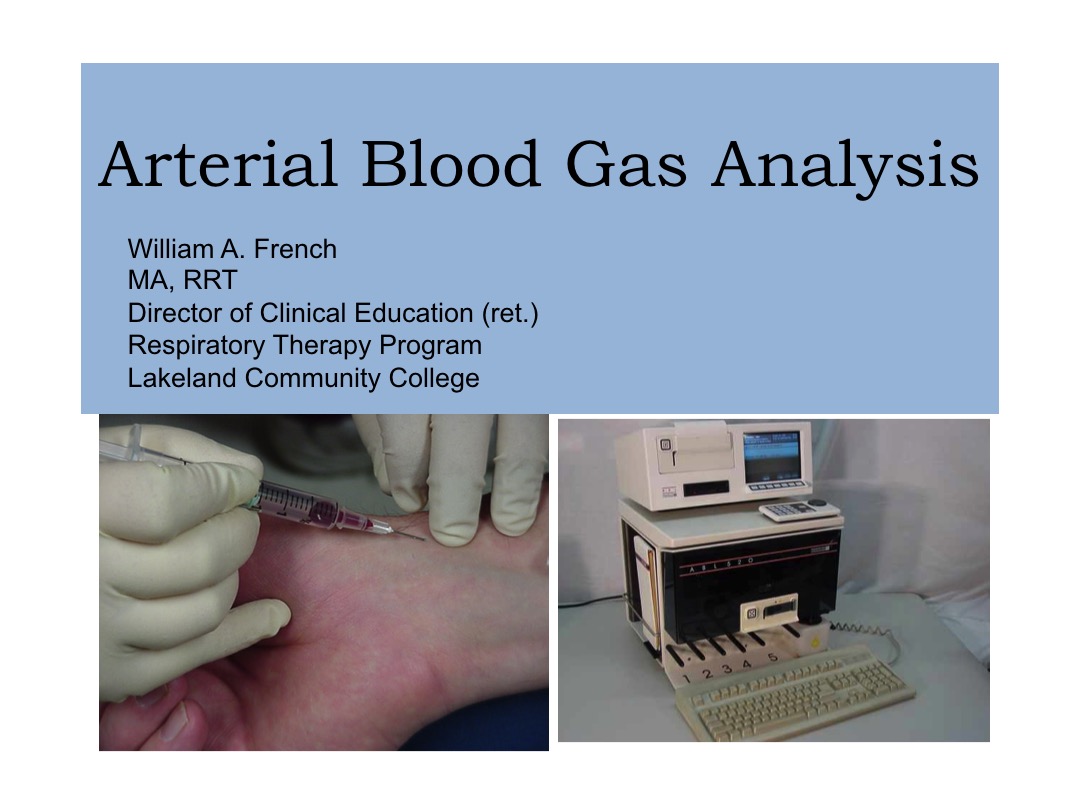Arterial Blood Gas EKG Interpretation | EKG.Academy
Your online EKG class

Lessons
Lesson #1: Overview
Title Slide

Learning Objectives
Upon successful completion of this lesson, the learner will be able to:
- List the indications for obtaining and analyzing arterial blood
- List the hazards associated with arterial puncture
- Describe the procedure for obtaining blood from an artery
- Discuss the reasons why the radial artery is preferred
- Describe the Allen test
- List possible sources of error when obtaining and analyzing arterial blood
- List the values typically measured by a standard blood gas analyzer
- List the values typically measure by a co-oximeter
- Describe the various quality control measures used to assure the accuracy of blood gas values, including Levey-Jennings data
Using This Presentation

Lesson #2: Core Values
Core Values

Lesson #3: Indications
Indications

Data Obtained

Lesson #4: Arterial Puncture
Intro

Additional text to explain a slide can be easily placed below any slide in the presentation.
Images

Arteries of Choice

Lesson #5: Radial Artery
Radial Artery 1

Radial Artery 2

Radial Artery 3

Radial Artery 4

Lesson #6: Brachial Artery
Brachial Artery 1

Brachial Artery 2

Lesson #7: Femoral Artery
Femoral Artery 1

Femoral Artery 2

Lesson #8: Allen Test
Allen Test

Lesson #9: Procedure 1
Procedure 1.1

Procedure 1.2

Lesson #10: Procedure 2
Procedure 2.1

Procedure 2.2

Procedure 2.3

Lesson #11: Blood Gas Analysis
Blood Gas Analysis 1

Blood Gas Analysis 2

Co-oximetry

Lesson #12: Blood Gas Analyzer
Typical Blood Gas Analyzer

Blood Gas Analyzer Images 1

Blood Gas Analyzer Images 2

Blood Gas Analyzer Images 3

Lesson #13: Electrodes
pH Electrode

PCO2 Electrode

PO2 (Clark)

Lesson #14: Errors
Sources

Analytical

Measuring

Lesson #15: Quality Control
Summary

Levey-Jennings

Chart

Lesson #16: Conclusion
Summary
The main points of this presentation:
- The indications for blood gas analysis
- Arterial puncture locations in priority order
- Procedures for obtaining arterial blood
- Blood analysis, analyzers and electrodes
- Blood gas analysis errors and quality control methods
Lesson #17: Quiz 1
Question #1
You are asked to obtain arterial blood from a 60-year-old patient receiving mechanical ventilation. Which of the following is the preferred artery?
B. brachial
C. dorsalis pedis
D. radial
Question #2
When obtaining blood from the radial artery, which of the following is the ideal angle of entry (in degrees)?
B. 30 - 45
C. 45 - 60
D. 90
Question #3
Which of the following is not a possible hazard associated with arterial puncture?
B. hemorrhage
C. infection
D. air contamination
Question #4
Which of the following is the preferred needle size when obtaining blood from the radial artery (in gauge)?
B. 20 - 22
C. 22 - 23
D. 25
Lesson #18: Quiz 2
Question #1
Which of the following is not a value measured by the typical blood gas analyzer?
B. PO2
C. PCO2
D. HCO3
Question #2
Which of the following values requires a co-oximeter to measure?
B. SO2
C. HCO3
D. pH
Learn More
Blood Gas Interpretation LessonsReturn to Main Lessons Page
Authors and Reviewers
- EKG heart rhythm modules: Thomas O'Brien.
- EKG monitor simulation developer: Steve Collmann
-
12 Lead Course: Dr. Michael Mazzini, MD.
- Spanish language EKG: Breena R. Taira, MD, MPH
- Medical review: Dr. Jonathan Keroes, MD
- Medical review: Dr. Pedro Azevedo, MD, Cardiology
- Last Update: 11/8/2021
Sources
-
Electrocardiography for Healthcare Professionals, 5th Edition
Kathryn Booth and Thomas O'Brien
ISBN10: 1260064778, ISBN13: 9781260064773
McGraw Hill, 2019 -
Rapid Interpretation of EKG's, Sixth Edition
Dale Dublin
Cover Publishing Company -
12 Lead EKG for Nurses: Simple Steps to Interpret Rhythms, Arrhythmias, Blocks, Hypertrophy, Infarcts, & Cardiac Drugs
Aaron Reed
Create Space Independent Publishing -
Heart Sounds and Murmurs: A Practical Guide with Audio CD-ROM 3rd Edition
Elsevier-Health Sciences Division
Barbara A. Erickson, PhD, RN, CCRN -
The Virtual Cardiac Patient: A Multimedia Guide to Heart Sounds, Murmurs, EKG
Jonathan Keroes, David Lieberman
Publisher: Lippincott Williams & Wilkin)
ISBN-10: 0781784425; ISBN-13: 978-0781784429 - Project Semilla, UCLA Emergency Medicine, EKG Training Breena R. Taira, MD, MPH